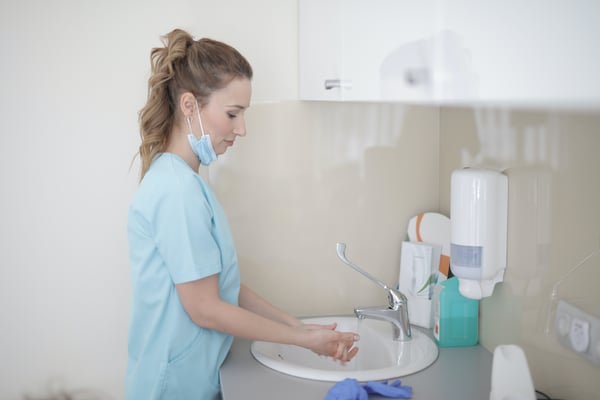In 2020 the American Nurses Foundation began a series of Workplace Pulse Surveys to assess how nurses perceived their organizations’ performance in dealing with a number of issues related to the pandemic: staffing, scheduling, the work environment, vaccination rates, availability of personal protective equipment (PPE), the personal mental health and well-being of respondents, and the likelihood of nurses deciding to either leave their current position or the nursing profession entirely. A source like these American Nurses Association (ANA) surveys, with over 11,000 nurses responding to last year’s survey, provides a more comprehensive and therefore statistically significant understanding of what's really occurring in the nursing labor market than do the published findings from much smaller studies. Last year’s respondents were primarily acute care nurses (58%) and nurses at the bedside (73%), a composition of nurses that organizations are extremely interested in hearing from. This article reviews some of the study’s key findings along with offering some suggestions for change based on the feedback provided.

From the pulse survey we learned that short staffing was the norm, resulting in 59% of the nurses being asked to work an extra shift, to work beyond their schedule, or being unable to take any paid time off (e.g.vacation time). Seventy-two percent reported insufficient numbers of ancillary staff and the “wrong” skill mix of nurses. Many of the recent graduates and the younger practicing nurses were not prepared for the complexity of caring for pandemic patients (i.e. the complexity gap); in fact, 30% of the working nurses reported not feeling prepared to practice on their own at all. The intensity and acuity of the patients, and having so many of them die was stressful for all and overwhelming for some. Unfortunately at the very time these nurses, especially the younger ones, needed support. Respondents to several questions indicated their organizations were being anything but supportive. Survey scores for feeling supported by their organization were 2.9 on the 5.0 scale, feeling heard by their organization scored at 2.7 out of 5.0, and the organization responding to my complaints or concerns scored at 2.7 out of 5.0.
To get the latest episodes sent straight to your inbox, subscribe here.
Yet another impact of the pandemic was a dramatic increase in bullying, incivility and violence within the work environment. 65% of hospital-based nurses reported bullying and incivility at work, with 40% experiencing acts of violence. Nine times out of ten it was either patients or families (primarily patients), who perpetrated violence against a nurse. There was also a significant increase in bullying behavior and incivility aimed at nurses on the part of physicians. As a result of all these disturbing developments, there was great concern about the prospect of nurses concluding they needed to either leave their current position or the nursing profession entirely. We now know that 100,000 nurses did indeed leave the workforce during the pandemic primarily due to staffing and workload, the work environment and the absence of any work-life balance. Many assumed the majority of the 100,000 RNs who resigned during this period were retiring, but findings from another study indicated the majority of this population was either under the age of 35 or between the ages of 35 and 49.
.jpg?width=600&height=400&name=pexels-rodnae-productions-6129688%20(3).jpg)
So what are the strategies to improve the work environment and entice nurses back to the bedside? The ANA Workplace Pulse Surveys provides us with some clues. For the first time, salary is the number one issue for nurses. In the past it was the work environment that ranked first on the issues list, but apparently no longer. Nurses feel under compensated for what they've been through these past several years, so reassessing nursing total compensation needs to be a top priority for organizations moving forward. Vivian Health’s latest “Future of Healthcare Work Report” indicates that nurses currently in traveler positions are expecting no less than $61 per hour (a slight decrease from last year’s $65 per hour) to return to a permanent nursing role. Another issue requiring organizational attention is to assure that leaders are genuinely listening to, empathizing with, and validating what nurses have been through. The ANA study indicated that some organizations never even asked nurses how they were doing. So making extra efforts to be visible and talking to the staff is critically important. Another area to address is the level of bullying, incivility and violence that has been taking place. Nurses are unable to provide the best possible care if they are fearful for their safety and their own personal well-being, so leaders also need to be mindful of staff fatigue, stress, and burnout. Be sure to reassess if your policies and procedures are current, consider re-education about safe work environments, and work with your Employee Assistance Program to be sure staff are aware of and can take advantage of this employee benefit whenever the need arises.
The American Nurses Association Workplace Pulse survey data reveals actionable information for organizations to (re)build staffing, and to deliver inclusive, healthy, and safe work environments. RNs need to feel both physically and psychologically safe in order to provide the best patient care.
Check out this episode on our educational series, On the Horizon in Healthcare, on YouTube. For more information on how to effectively attract talent, schedule a demo.
Subscribe here to get the latest episodes
